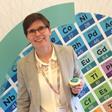Use these tips and activities to link UN sustainable development goal 7 to your lessons on energy, hydrogen, sustainability and esterification

A key part of studying science at any age is to appreciate and understand its uses and significance to society. Science is vital if we are to solve global challenges such as the one presented in Goal 7: ensure access to affordable, reliable, sustainable and modern energy for all.
To fully appreciate the challenge this goal presents, students need to be aware of past and current technologies and their environmental impact. They should also be introduced to more recent scientific developments in energy production.

This article is part of the Sustainability in chemistry series, developed to help you integrate the UN’s Sustainable development goals into your teaching of chemistry. It supports Goal 7: ensure access to affordable, reliable, sustainable and modern energy for all.
At 11–14 students formally meet the concept of energy and the different sources of energy for the first time. The difference between non-renewable and renewable energy sources and their respective advantages and disadvantages are considered alongside the impact of human activity and energy use on the climate. At 14–16 this knowledge is extended and alternative energy sources such as bioethanol and hydrogen fuel cells are introduced.
Put it in context
The generation we are currently teaching are the catalysts for change and some will go on to be the scientists of the future. Their opinions will drive government policy and their discoveries help societies across the world develop sustainably.
It is important students understand that scientific ideas are not just a lucky guess, but that knowledge develops through scientific research and peer review. Our scientific understanding only moves forward when scientists ask questions and find the answers to these questions by carrying out different types of scientific enquiry. You can interweave and develop the ideas of scientific discovery through the curriculum using a range of different contexts: energy production is one of these contexts.
Download this
Discussion activity, for ages 11–16
This classroom activity includes viewpoints from an international team of advisers on fossil fuels and global carbon emissions. Learners explore and debate the issues and then make an informed policy decision.
Download the discussion prompts as MS PowerPoint or as a student handout as MS Word or pdf, and the accompanying teacher notes as MS Word or pdf.
Fundamental to understanding energy is knowing that energy cannot be created or destroyed – it can only be transferred from one store to another. We may discuss energy production when looking at energy sources, but this can introduce misconceptions. When talking about different energy sources, emphasise the energy stores and transfers involved. Using the energy stores and transfers model typically used in physics will help students to see the link between the different science disciplines and appreciate the interdisciplinary nature of scientific discovery.
Put it into practice
Greta Thunberg and the recent School Strike for Climate movement has raised the profile of climate change with the younger generation. Tap into this interest and spark a lively debate using the downloadable resource (above) in which students act as a policy maker and decide what their policy is on the use of fossil fuels for energy. Looking at the opinions of a range of different advisers will allow students to see the full challenge Goal 7 presents. Before beginning the debate, ensure students have a firm understanding of the chemistry behind climate change using the ideas and tips in How to teach the carbon cycle.
Students learn about biofuels as a potentially carbon-neutral alternative to burning fossil fuels for energy production. Students can produce their own bioethanol from the fermentation of sugar (suitable for 14–16 age range) or produce biodiesel from the transesterification of vegetable oil (16–18) and compare the products to more readily available fuels such as paraffin. During the practical activities ask your students to consider why these alternative fuels might not be used globally and how governments could act to encourage their wider uptake.
Hydrogen fuel cells are fast becoming one potential alternative energy source. With your 16–18 students, you can link this to their understanding of energetics and redox equilibria using the article Fuelling the future and the associated worksheet.
A number of cities now have hydrogen-powered buses and hydrogen-powered cars are available to buy. Use these examples to show students that this technology really is a viable alternative to fossil fuels. Follow direct instruction to teach the chemistry involved in the hydrogen fuel cell with discussions on the advantages and disadvantages of this technology (suitable for 14–18 age range). Why do students think NASA plan to use hydrogen fuel cells for future manned landing missions, including the planned trip to Mars in the 2030s?
To meet the challenge Goal 7 presents and use hydrogen as a future energy source, new technology must be developed that does not rely on electricity to produce hydrogen by the electrolysis of water. In this video clip from the RI Christmas lectures in 2012 one such revolutionary technology is demonstrated in which acatalyst is used to split water into hydrogen and oxygen using UV light. Is this the future?
More resources
- Find experiments and worksheets exploring the potential of solar energy with the Solar spark resources.
- Link to careers with this job profile of a laboratory technician who tests solar panels; find more inspiration with our Fixing the future video.
- Create context with scientific research using starter slides on Recycling plastic bottles into jet fuel and Merging solar cell and battery tech.
- Use our organic chemistry worksheets for 14–16 years to check knowledge of the underlying chemistry of hydrocarbons and help put it into context.
Check out the rest of the Sustainability in chemistry series.














No comments yet